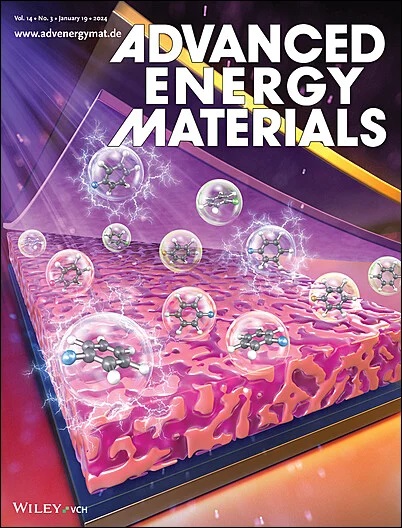Tuning Polysulfides into Clustered-States via Non-coordinating Molecular Encapsulation to Achieve an Alternative Kinetics in Li─S Batteries
IF 24.4
1区 材料科学
Q1 CHEMISTRY, PHYSICAL
引用次数: 0
Abstract
The practical application of lithium–sulfur batteries is hindered by the polysulfide shuttle effect and sluggish kinetics inherent in solid–liquid–solid conversion mechanism, particularly under lean electrolyte conditions (<5 µL mg⁻¹). Weakly solvating electrolytes and localized high-concentration electrolytes can suppress polysulfide dissolution and enable a quasi-solid-phase mechanism but suffer from severely limited reaction kinetics. Herein, a clustered-polysulfide-mediated sulfur conversion mechanism enabled by a novel electrolyte composed of 1,2-dimethylbenzene (DTL) and 1,2-dimethoxyethane (DME) is proposed. The encapsulation effect of DTL and the coordination of TFSI⁻ with polysulfides drives the aggregation of polysulfides so that the clustered polysulfides with virtual shell boundaries can be the new basic reactive that bridges the gap between the traditional dissolution-dominated mechanism and quasi-solid-state mechanism. The clustered polysulfide electrolyte (CPE) not only suppresses the shuttle effect and stabilizes the lithium anode by mitigating parasitic reactions but also enables alternative reaction kinetics and promotes 3D Li₂S deposition, minimizing electrode passivation. Ultimately, lithium–sulfur batteries can achieve excellent electrochemical performance and can stably operate under lean electrolyte (<4.0 µL mg⁻¹) with an area capacity of >4 mAh cm−2. This work elucidates the relationship between polysulfide dissolution behavior and redox kinetics, providing a new insight into the understanding of complex sulfur conversion mechanisms.

通过非配位分子封装将多硫化物调谐成团簇态,在锂离子电池中实现替代动力学
本文章由计算机程序翻译,如有差异,请以英文原文为准。
求助全文
约1分钟内获得全文
求助全文
来源期刊

Advanced Energy Materials
CHEMISTRY, PHYSICAL-ENERGY & FUELS
CiteScore
41.90
自引率
4.00%
发文量
889
审稿时长
1.4 months
期刊介绍:
Established in 2011, Advanced Energy Materials is an international, interdisciplinary, English-language journal that focuses on materials used in energy harvesting, conversion, and storage. It is regarded as a top-quality journal alongside Advanced Materials, Advanced Functional Materials, and Small.
With a 2022 Impact Factor of 27.8, Advanced Energy Materials is considered a prime source for the best energy-related research. The journal covers a wide range of topics in energy-related research, including organic and inorganic photovoltaics, batteries and supercapacitors, fuel cells, hydrogen generation and storage, thermoelectrics, water splitting and photocatalysis, solar fuels and thermosolar power, magnetocalorics, and piezoelectronics.
The readership of Advanced Energy Materials includes materials scientists, chemists, physicists, and engineers in both academia and industry. The journal is indexed in various databases and collections, such as Advanced Technologies & Aerospace Database, FIZ Karlsruhe, INSPEC (IET), Science Citation Index Expanded, Technology Collection, and Web of Science, among others.
 求助内容:
求助内容: 应助结果提醒方式:
应助结果提醒方式:


